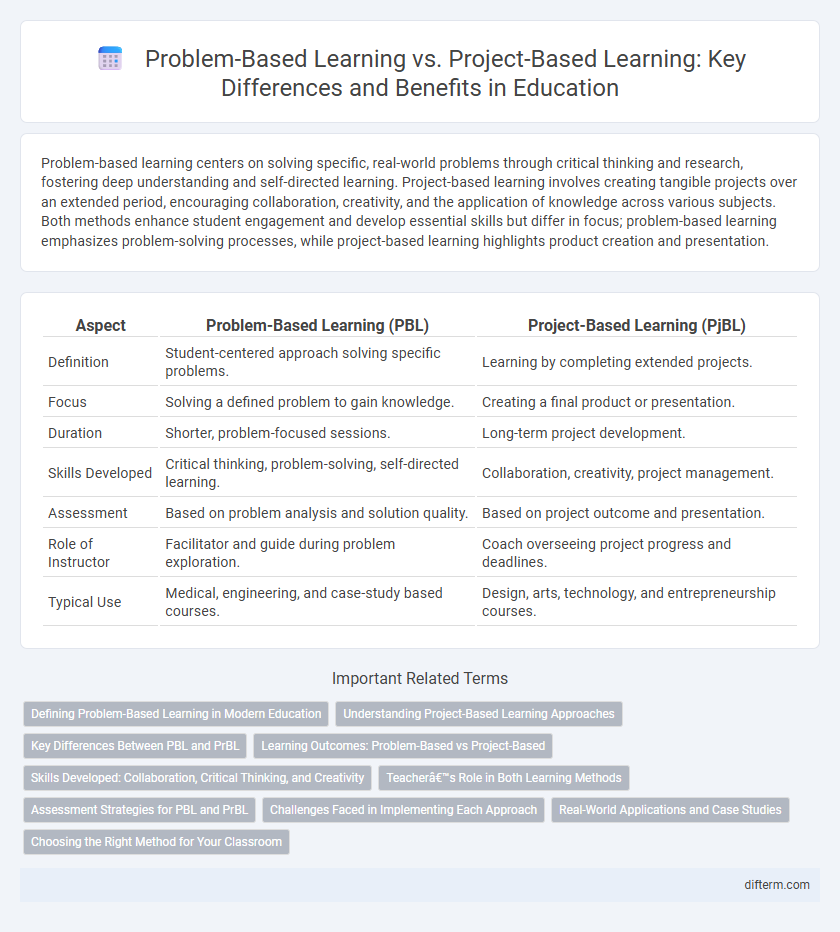Problem-based learning centers on solving specific, real-world problems through critical thinking and research, fostering deep understanding and self-directed learning. Project-based learning involves creating tangible projects over an extended period, encouraging collaboration, creativity, and the application of knowledge across various subjects. Both methods enhance student engagement and develop essential skills but differ in focus; problem-based learning emphasizes problem-solving processes, while project-based learning highlights product creation and presentation.
Table of Comparison
| Aspect | Problem-Based Learning (PBL) | Project-Based Learning (PjBL) |
|---|---|---|
| Definition | Student-centered approach solving specific problems. | Learning by completing extended projects. |
| Focus | Solving a defined problem to gain knowledge. | Creating a final product or presentation. |
| Duration | Shorter, problem-focused sessions. | Long-term project development. |
| Skills Developed | Critical thinking, problem-solving, self-directed learning. | Collaboration, creativity, project management. |
| Assessment | Based on problem analysis and solution quality. | Based on project outcome and presentation. |
| Role of Instructor | Facilitator and guide during problem exploration. | Coach overseeing project progress and deadlines. |
| Typical Use | Medical, engineering, and case-study based courses. | Design, arts, technology, and entrepreneurship courses. |
Defining Problem-Based Learning in Modern Education
Problem-Based Learning (PBL) in modern education emphasizes student-centered inquiry, where learners investigate complex, real-world problems without predetermined solutions, fostering critical thinking and analytical skills. This approach contrasts with traditional methods by prioritizing collaboration, self-directed learning, and the application of interdisciplinary knowledge. PBL enhances engagement and deep understanding by encouraging students to identify knowledge gaps and develop problem-solving strategies actively.
Understanding Project-Based Learning Approaches
Project-based learning emphasizes hands-on, student-driven investigations that culminate in tangible products, encouraging collaboration, critical thinking, and real-world application of knowledge. Unlike problem-based learning, which centers on resolving specific issues through guided inquiry, project-based learning integrates broader thematic concepts across extended timelines. This approach fosters deeper engagement by allowing learners to explore complex questions, manage time effectively, and develop interdisciplinary skills essential for academic and career success.
Key Differences Between PBL and PrBL
Problem-based learning (PBL) centers on students tackling complex, real-world problems without predetermined solutions, fostering critical thinking and self-directed inquiry. Project-based learning (PrBL) involves students creating tangible projects over an extended period, emphasizing collaboration, creativity, and practical application of knowledge. Key differences include PBL's focus on problem exploration and solution development, whereas PrBL prioritizes product creation and presentation.
Learning Outcomes: Problem-Based vs Project-Based
Problem-based learning (PBL) enhances critical thinking and problem-solving skills by engaging students with real-world scenarios requiring in-depth analysis and solution formulation. Project-based learning fosters collaboration, creativity, and practical application by guiding students through complex projects that produce tangible outcomes. Both approaches improve retention and understanding, but PBL emphasizes cognitive skill development, while project-based learning prioritizes teamwork and product creation.
Skills Developed: Collaboration, Critical Thinking, and Creativity
Problem-based learning develops critical thinking and collaboration by engaging students in solving real-world problems through inquiry and discussion. Project-based learning enhances creativity and teamwork by requiring students to design and create tangible products or presentations over an extended period. Both methods cultivate essential 21st-century skills, with problem-based learning emphasizing analytical reasoning and project-based learning fostering innovation and cooperative execution.
Teacher’s Role in Both Learning Methods
In problem-based learning, the teacher acts as a facilitator who guides students to identify problems, ask questions, and develop critical thinking skills without providing direct solutions. In project-based learning, the teacher takes on a more directive role by designing projects, setting clear goals, and monitoring progress to ensure students apply knowledge in real-world contexts. Both methods emphasize active learning, but the teacher's involvement varies from indirect guidance in problem-based learning to active supervision and support in project-based learning.
Assessment Strategies for PBL and PrBL
Assessment strategies for Problem-based Learning (PBL) emphasize formative evaluation through continuous feedback, self-assessment, and peer-assessment to gauge students' critical thinking and problem-solving skills. Project-based Learning (PrBL) assessment predominantly involves summative evaluation based on the final project outcome, presentation, and real-world application of knowledge, with rubrics aligning to learning objectives. Both methods benefit from integrating reflective assessments and collaborative evaluation to enhance student engagement and learning effectiveness.
Challenges Faced in Implementing Each Approach
Problem-based learning often encounters challenges such as student resistance to self-directed inquiry and the need for extensive facilitator expertise to guide open-ended problems effectively. Project-based learning faces difficulties including resource constraints, time management issues, and ensuring authentic assessment of collaborative efforts. Both approaches require significant shifts in traditional teaching methods, demanding comprehensive teacher training and curriculum redesign to successfully implement.
Real-World Applications and Case Studies
Problem-based learning (PBL) emphasizes solving complex, real-world problems through critical thinking and collaborative inquiry, fostering deeper understanding and practical application of knowledge. Project-based learning (PjBL) involves students creating tangible products or presentations connected to authentic tasks, integrating interdisciplinary skills and promoting sustained engagement with real-world scenarios. Both approaches leverage case studies and authentic contexts to enhance student motivation and prepare learners for professional challenges in various fields.
Choosing the Right Method for Your Classroom
Problem-based learning (PBL) emphasizes critical thinking and problem-solving by presenting students with real-world challenges, ideal for developing diagnostic skills in subjects like medicine and engineering. Project-based learning focuses on creating tangible outcomes through extended tasks, encouraging creativity and collaboration, particularly effective in arts and technology classrooms. Selecting the right method depends on curriculum goals, student needs, and desired skill development, balancing depth of inquiry with hands-on application.
Problem-based learning vs Project-based learning Infographic

 difterm.com
difterm.com